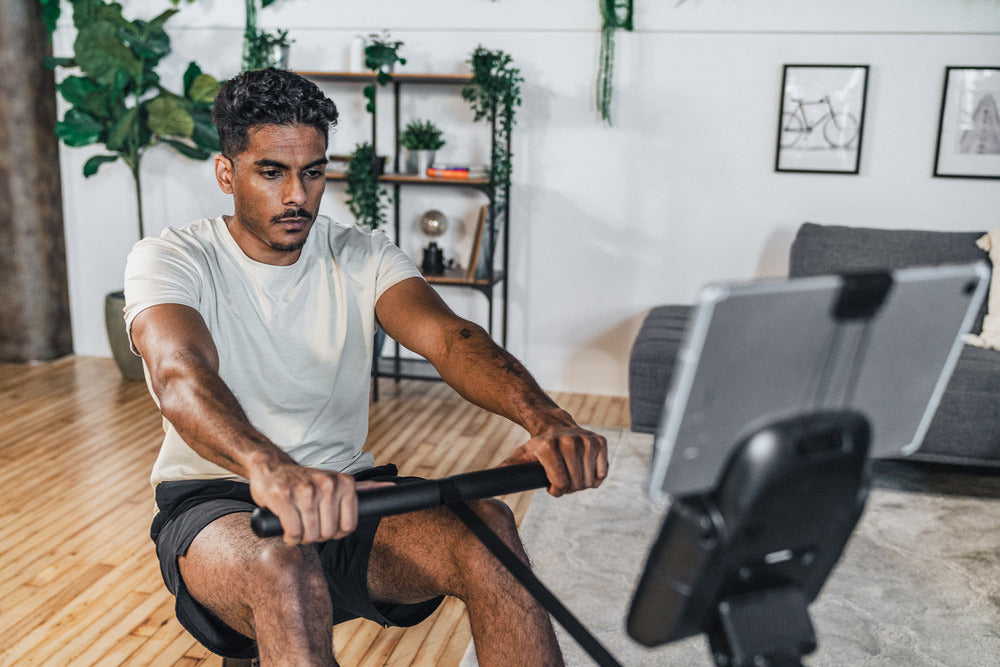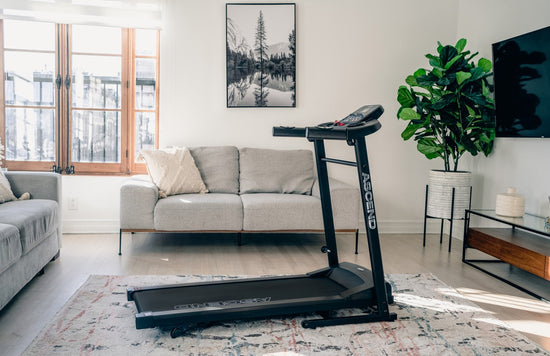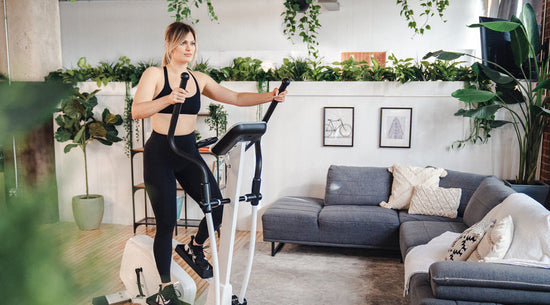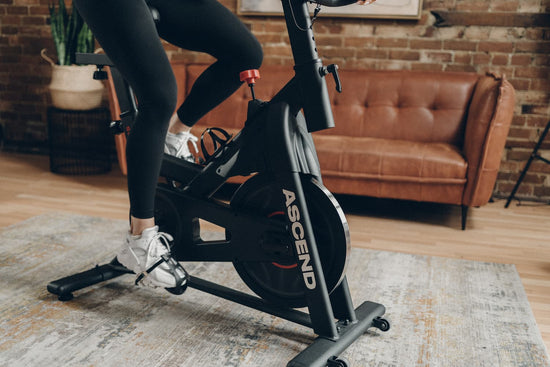
How many calories can you burn rowing?
Burning more calories in a shorter amount of time and exerting less energy than you would running? Sounds like a dream, right?
Except… it’s real and quite achievable by using a rowing machine. An indoor rowing machine is designed to help you mimic the intense action of rowing a boat, thus giving you a full-body low-impact workout while torching calories within a shorter duration than running.
Let’s look at how effective an indoor rowing machine is, how many calories you can burn through a rowing machine workout, and some expert tips on how you can maximize your calorie burn.
Benefits of using a rowing machine
If you’ve ever taken a ride on a rowboat or kayak, you may have noticed how strong those who row them are. And if you’ve ever attempted to row them yourself, you’ll remember how gassed you quickly got. But rowing doesn’t just have physical benefits, it has mental ones, too. Let’s look at a few below:
It helps with weight loss
The process of losing weight can be condensed into a simple formula: the number of calories you burn should be greater than the number of calories you consume. If you remain consistent with your calorie intake and take part in some moderate rowing for an hour every day, you can burn calories and maintain a healthy calorie deficit which will help you lose weight.
Rowing at a moderate pace increases your heart rate to around 65 to 75%+ of your maximum heart rate. When within 65%-75%, this is known as the fat burning zone. So, rowing helps you burn fat, (including your belly fat), strengthens, and defines your muscles. To get the best results, add rowing to your weight loss regimen for 30 minutes to an hour a day, five times a week. Supplement your routine with a proper diet, and don’t forget to be consistent with your efforts to see results.
Is rowing good to lose belly fat?
Rowing is good to lose belly fat since it targets muscle groups all over your body, including the muscles in your belly region. When you row, your heart rate elevates, bringing your body to the fat burning zone, so you burn off fat, including your belly fat.
It improves your heart health
Rowing is a cardio exercise, which means it strengthens your entire cardiovascular system. Because of the intensity of the activity, your heart rate gets elevated during a rowing workout. When this happens, your heart works a bit harder to get the blood flowing through your body. This improves your heart health by increasing your muscles’ ability to pull oxygen out of your blood, lowering your blood pressure and cholesterol, and reducing your risk for various diseases.
Because cardio exercises also improve air circulation throughout your body, rowing is good for your lungs, too.
It’s a full-body workout
Rowing works almost all the major muscles in your body, so you effectively get a full-body workout for the price of just a cardio workout.
Since a full-body workout stimulates multiple muscle groups such as the ones on your legs, core, shoulders, and arms, it works as a strength and endurance training exercise and helps you build power.
Your back also gets a workout, which improves your upper spine posture. This is especially important today where a majority of us spend our time looking down at our phones or laptops.
It’s low-impact
Rowing is a low-impact workout because it doesn’t stress out your joints as much as other cardio machines such as treadmills or the stairmaster. Moreover, since it’s an exercise that you do sitting down, your back and knees don't experience a lot of wear and tear as well. This means rowing is a physical activity suitable for people of all ages and fitness levels.
It’s good for your mental health
Rowing, as with any physical activity, boosts your mental health and reduces symptoms of anxiety and depression. The rowing rhythm can help you enter a meditative state which calms you down. Rowing, like all exercise, also releases endorphins, which elevates your general mood.
You can also practice mindfulness while rowing by focusing only on counting the strokes. This encourages you to stay in the present without worrying about the past or the future, reducing stress and anxiety. Since every stroke requires your confidence and focus, you also build mental resilience.
Now, for the question of the hour...
How many calories does rowing burn?
An average person weighing 135 pounds (or 61 kgs), rowing at a power of 100 watts, burns around 450 - 700 calories per hour. When the power is increased to 200 watts, the same person burns around 750 - 1150 calories.
Calories burned in an hour by a person weighing 135 lbs (61 kgs):
100 watts |
150 watts |
200 watts |
451 |
548 |
773 |
Calories burned in an hour by a person weighing 150 lbs (68 kgs):
100 watts |
150 watts |
200 watts |
501 |
609 |
859 |
Calories burned in an hour by a person weighing 175 lbs (79.3 kgs):
100 watts |
150 watts |
200 watts |
585 |
710 |
1002 |
These numbers are derived using this simple formula:
(MET x body weight in kilograms x 3.5)/ 200 = calories burned in 1 minute
Here, MET stands for the metabolic equivalent of any task you do. The more intense your activity, the higher the MET value. So, vigorous rowing at a pace of 150 watts will have a higher MET value than rowing at a moderate intensity of 100 watts, which means you’ll burn more calories.
How many calories do you burn on a rowing machine after 15 minutes?
The actual number of calories burned rowing depends on several factors such as your weight, the intensity of your workout routine, and the total duration of your workout. Here’s a table that gives you a good idea of how many calories an average person weighing 150 lbs (or 68 kgs) can expect to burn during a 15 minute rowing session:
100 watts |
150 watts |
200 watts |
125 |
152 |
215 |
How many calories does 20 minutes on a rowing machine burn?
Using a person who weighs 150 lbs (or 68 kgs) as a frame of reference, here’s how many calories they would burn after 20 minutes of rowing:
100 watts |
150 watts |
200 watts |
167 |
203 |
286 |
How long does it take to burn 500 calories on a rowing machine?
Moderate rowing helps an average person burn 500 calories in just an hour.
However, the exact number of calories you burn during a rowing workout depends on several factors.
Factors affecting the number of calories burned while rowing
Three important factors affect the number of calories burned on a rowing machine: your weight, the duration of your rowing training, and the intensity with which you work out. You can use these factors to curate your own workout sessions for maximum calorie burn.
Weight
Two people of different weights using a rowing machine at the same intensity will burn different amounts of calories. The heavier person will burn more calories compared to the lighter person.
This is because the more you weigh, the harder you need to work in order to perform the same physical task. When you work harder, your body naturally burns more calories. So, after 30 minutes of indoor rowing at the same pace, a person who weighs 150 lbs (68 kgs) would have burned fewer calories than someone who weighs 200 lbs (90.7 kgs).
Workout duration
The longer your rowing machine workout, the more your rowing machine calorie burn. Think about it. Your body burns calories for every minute you spend using a rowing machine. So, when you increase the entire duration of your workout, it’s only natural that the number of calories burned rowing also increases.
Workout intensity
Your exercise intensity impacts calories burned. If you want to burn more calories, you need to apply more power to your rowing. Rowing vigorously helps you burn off more calories in a shorter period of time, because it’s all about power. The more power you apply, the more energy you use, and the more calories you burn. In short, maximum effort leads to maximum calorie burn.
For example, if you can burn 501 calories in an hour rowing at 100 watts, you’ll be able to achieve the same amount of calorie burn in a shorter duration upon increasing the power you apply.
Tips for maximizing your rowing machine calorie burn
Want to get the most of your rowing technique? Here are some expert tips to help you maximize the calories burned on your rowing fitness machine.
Add variety to your rowing workouts
When you use the same exercise routine for a long time, your body gets better at it. This lowers your heart rate, which means you burn fewer calories. So, it’s necessary for you to switch up your workouts every few weeks to keep your body in peak fat-burning mode.
Vary your rowing stroke rate
Start off with a much slower pace of 18-20 strokes per minute. After maintaining this speed for 2 to 3 minutes, go up one stroke and sustain the speed till you get used to it. After another couple of minutes, go up another stroke. Repeat this process till you reach a speed of 30 strokes per minute.
Once you hit 30 strokes per minute, start reversing your speed till you come down to the speed you started with. This is a great method of adding speed and intensity to your workout routine even if you are not ready for HIIT workouts yet.
Incorporate HIIT into your workouts
Once you have at least six months of rowing experience, it might be time to start on HIIT workouts. HIIT stands for High Intensity Interval Training and is an excellent way to burn calories even faster and lose weight.
A HIIT workout consists of alternating between high-intensity rowing and low-intensity rowing. In order to do this, first begin with a warm up session where you maintain a moderate intensity of around 18-20 strokes per minute. After a few minutes, switch to rowing vigorously with a speed of 26-28+ strokes per minute. Repeat this cycle with some rest intervals in between.
A high-intensity rowing workout also induces EPOC (Excess Post-Exercise Oxygen Consumption), also known as the afterburn effect, in which you continue burning calories long after your workout is over. So, when you factor in this effect, a HIIT workout provides a greater fat burning upside.
Add resistance training
A cool trick is to incorporate bouts of resistance training in your rowing workouts. Mixing these two types of exercises puts your body through both aerobic and anaerobic states. Rowing at a moderate intensity is considered an aerobic exercise, while weight training is considered an anaerobic exercise, in which your oxygen demand surpasses your body’s oxygen supply. When performing anaerobic exercise, your body and lungs are forced to pull the energy stored in your muscles, including your sugar-based energy, thereby burning calories. Combine it with rowing, and you’ll quickly torch calories.
For example, you can alternate 10 minutes of rowing with 10 rounds of push-ups, pull-ups, squats, crunches, or weight lifting.
Focus on your legs
Most of the bigger muscles are found on the lower half of your body, which means there’s a big opportunity for increased calorie burn while working your legs at a high intensity. Focus on your legs and make sure that you drive them into the heel rest with each stroke.
Conclusion
Rowing is an effective way of burning calories fast, especially when you are trying to lose weight. Shop Ascend rowing machines to try out this low-impact full-body exercise for yourself.




